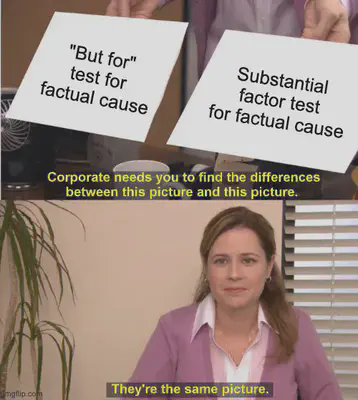Factual Cause Review
Toxic Harms
Why is the tort system such a poor fit?
Three frequent problems:
- Identification of the cause: Can’t be certain that the toxin was a “but for” cause
- Boundaries of the harm: Can’t be certain of the extent of the harm
- Source of the cause: Can’t be certain who in particular is responsible
Mass Torts
A procedural story in two parts:
The Supreme Court killed the mass tort class action
Multidistrict litigation (MDL) took over
Factual Causation Speedrun
Causation
Two parts:
Two different tests for factual causation
Causation
Two parts:
- Factual cause
- Proximate cause
Two different tests for factual causation
- “But for”
- Substantial factor
—

Factual cause is usually straightforward
Make a factual cause argument for the plaintiff in each case
Con Edison was in charge of supplying electricity to New York City but negligently let a major power failure happen leaving New York City without electricity for days. Two days into the blackout, Julius Strauss walked into the unlit basement of his apartment building and fell down the stairs.
Jonathan Carter visited Ronald Kinney’s home for a bible study session, slipped on a patch of ice in Kinney’s driveway, and broke his leg.
Mary Jane Gerstheimer parked her car in front of a pharmacy at the Middletown Psychiatric Center and left it unattended with the keys in the ignition. Stephen Rushink, a patient at the facility, drove away in the car, struck a tree, and died.
—
Possible issues with factual cause
Maybe something other than negligence was the but-for cause.
Multiple possible defendants
- Each defendant’s negligence was enough to cause the harm, but remove any one defendant and the harm still happens.
- Only one defendant was the but-for cause but can’t figure out which one.
— All of the possible defendants were negligent and are before the court.
— Some of the possible defendants were negligent and some were not.
— It’s a whole industry that was negligent
Exercise #1
You are an attorney at a plaintiff’s side firm in the state of Loyola.
Luna Waters was driving her car and rolled to a stop at a red light. Just behind her on the road, Joseph Meyer was texting while driving and negligently rear-ended Waters’s car. Minutes later, another driver, Myla Morales, was lost in thought, awestruck by the idea that causation can never be directly observed but is always an inference vulnerable in some way to post hoc ergo propter hoc “since Y followed X, X must have caused Y,” and negligently rear-ended Meyer’s car, which struck Waters’s car a second time.
In one collision or the other, Waters sustained an injury to her neck. She doesn’t know which of the two accidents caused the injury. The doctors that treated her injury cannot determine whether it was the first or second impact that caused it.
Waters visits your office as a prospective client. She wants to know if she has a viable negligence claim against Meyer or Morales, who she should sue, and if she will win. Please advise her.
Exercise 2
Same initial fact pattern as the first exercise. Except now, in addition to being hit by Meyer and Morales, Waters was also hit by two other drivers who fled the scene.
In one of the four collisions, Waters sustained an injury to her neck. She doesn’t know which of the four accidents caused the injury. The doctors that treated her injury cannot determine which of the four impacts caused it.
Waters visits your office as a prospective client. She wants to know if she has a viable negligence claim against Meyer or Morales, who she should sue, and if she will win. Please advise her.
Exercise 3
You are an attorney at a plaintiff’s side firm in the state of Loyola.
A labor activist, Ayla Ross, comes to visit you in your office. She has been organizing workers at a slaughterhouse in the region. She’s learned that the slaughterhouse had been euthanizing chickens with a particular gas, BirdBeGone, for the many years. but stopped using the gas when it was taken off the market six months ago. The gas was banned by state authorities after emerging research indicated that human beings exposed to the gas could develop skin cancer and that the gas could induce miscarriages and result in severe birth defects.
Ross wants to talk with these workers about the possibility of suing the slaughterhouse for negligence. She is particularly interested in the possibility of a class action lawsuit so that the workers don’t need to litigate individual cases, but she knows that issues of causation can be challenging in toxic harm lawsuits.
For this question, assume that duty and breach can be proven. Please advise her on the most pertinent remaining issues.